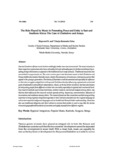Please use this identifier to cite or link to this item:
https://cris.library.msu.ac.zw//handle/11408/669Full metadata record
| DC Field | Value | Language |
|---|---|---|
| dc.contributor.author | Mapuwei, Nyasha | |
| dc.contributor.author | Orina, Gladys K. | |
| dc.date.accessioned | 2015-09-14T15:09:49Z | |
| dc.date.available | 2015-09-14T15:09:49Z | |
| dc.date.issued | 2013 | |
| dc.identifier.issn | 1815-9036 | |
| dc.identifier.uri | http://hdl.handle.net/11408/669 | |
| dc.description.abstract | East and Southern African music has been strikingly similar since time immemorial. The music industry in these respective regions have also been culturally rich and culturally open for further enrichment by coopting foreign dimensions as opposed to the traditional local recipe of music. Traditional music has also succumbed to exogenous forces. The most common genre that dominates music in both Zimbabwe and Kenya stubbornly remains Kanindo music, despite the emergence of numerous contemporay genres that appeal to the younger generation. The history of Kanindo is well documented and especially its influence on liberation struggles wedged both in Kenya and Zimbabwe thereby influencing regional and continental goals of nationalism and political independence. Music, as the key driver of culture, has been also known for integrating people from different societies into one entity especially at regional and continental level. Key research methods used include interviews, archival research, and textual analysis among others. Keytheories that influenced the research include agenda setting, hegemony, representation, difussion of innovations and mediation among others. The research found out that musicians use their song writing expertise to bring regional integration agendas to their listeners and often use the English language as well as their respective indigenous languages such as Swahili and Shona for better understanding. Musicians also use traditional allegories and short stories to express their points in such a way that the stories transcend geographical boundaries of countries and apply to people from different regions. | en_US |
| dc.language.iso | en | en_US |
| dc.publisher | Midlands State University | en_US |
| dc.relation.ispartofseries | The Dyke;Vol. 7, No. 1; p.110-127 | |
| dc.subject | Regional Integration, Popular Music, Kanindo, Sungura, Benga. | en_US |
| dc.title | The role played by music in promoting peace and unity in East and Southern Africa: the case of Zimbabwe and Kenya. | en_US |
| dc.type | Article | en_US |
| item.languageiso639-1 | en | - |
| item.openairecristype | http://purl.org/coar/resource_type/c_18cf | - |
| item.grantfulltext | open | - |
| item.fulltext | With Fulltext | - |
| item.cerifentitytype | Publications | - |
| item.openairetype | Article | - |
| Appears in Collections: | Research Papers | |
Files in This Item:
| File | Description | Size | Format | |
|---|---|---|---|---|
| mapuwei.pdf | 13.46 MB | Adobe PDF |  View/Open |
Page view(s)
136
checked on Aug 19, 2025
Download(s)
92
checked on Aug 19, 2025
Google ScholarTM
Check
Items in MSUIR are protected by copyright, with all rights reserved, unless otherwise indicated.



